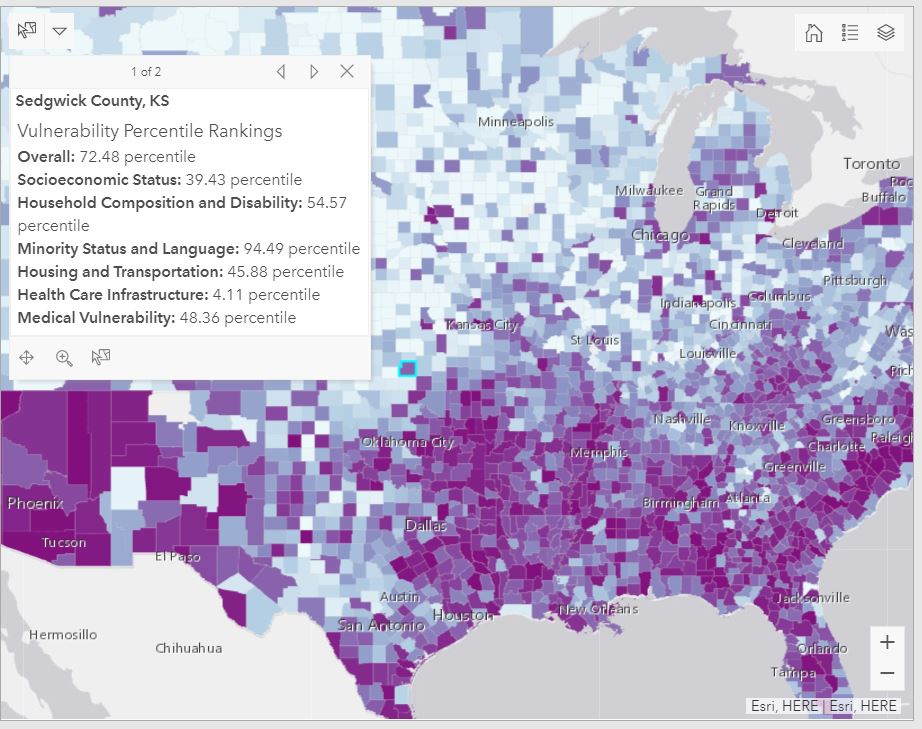CDC/ATSDR Social Vulnerability Index (CDC/ATSDR SVI)
CDC/ATSDR Social Vulnerability Index (CDC/ATSDR SVI): Overview
CDC/ATSDR SVI Overview
Social Vulnerability refers to the demographic and socioeconomic factors (such as poverty, lack of access to transportation, and crowded housing) that adversely affect communities that encounter hazards and other community-level stressors. These stressors can include natural or human-caused disasters (such as tornadoes or chemical spills) or disease outbreaks (such as COVID-19).
The Centers for Disease Control and Prevention and Agency for Toxic Substances and Disease Registry Social Vulnerability Index (hereafter, CDC/ATSDR SVI or SVI) is a place-based index, database, and mapping application designed to identify and quantify communities experiencing social vulnerability. The Geospatial Research, Analysis & Services Program (GRASP) maintains the CDC/ATSDR SVI to help public health officials and local planners better prepare for and respond to emergency events with the goal of decreasing human suffering, economic loss, and health inequities.
CDC/ATSDR SVI History
The Pandemic and All-Hazards Preparedness Act of 2006 cited that public health preparedness and response capabilities were critical needs for the nation. CDC/ATSDR and the Office of Environmental Health Emergency Management (OEHEM) decided to address social vulnerability as it relates to natural or human-caused hazards and public health emergencies. In 2007, a group including social scientists, geographers, and a statistician within the Geospatial Research, Analysis, and Services Program (GRASP) began developing the Social Vulnerability Index. The first CDC/ATSDR SVI database was released in 2011 and the team published the SVI approach and methodology in the paper titled, “A Social Vulnerability Index for Disaster Management” (Flanagan, B.E., Gregory, E.W., Hallisey, E.J., Heitgerd, J.L., & Lewis, B. (2011). A Social Vulnerability Index for Disaster Management. [PDF – 2 MB] Journal of Homeland Security and Emergency Management, 8(1).)
CDC/ATSDR SVI Methodology
The current CDC/ATSDR Social Vulnerability Index uses 16 U.S. census variables from the 5-year American Community Survey (ACS) to identify communities that may need support before, during, or after disasters. These variables are grouped into four themes that cover four major areas of social vulnerability and then combined into a single measure of overall social vulnerability.

View large image and text description
CSV of Overall Vulnerability image available here: CSV [XLS – 755 B].
CDC/ATSDR SVI Changes Over Time
The CDC/ATSDR SVI has changed four times over the years as can be seen in the timeline below:

View large image and text description
CSV of SVI Changes Over Time image available here: CSV [XLS – 858 B].
CDC/ATSDR SVI in Use
The CDC/ATSDR SVI databases and maps can help communities prepare for and recover from public health emergencies, and prevent adverse effects among socially vulnerable populations, such as emotional distress, loss of property, illness, and death.
- Emergency planners use the SVI to decide the number of emergency personnel needed, plan the best way to evacuate people, and account for socially vulnerable populations.
- Public health officials use the SVI to identify areas in need of emergency shelters and estimate the amount of supplies needed.
- State and local health departments and non-profits use the SVI to guide community-based health promotion initiatives.
CDC/ATSDR SVI County Map Series
The CDC/ATSDR SVI County Map Series include maps of the overall social vulnerability scores, as well as the four themes. These maps depict the SVI rankings of communities, at the census tract level, within a specified county.

Use this link to access the County Map Series
CDC/ATSDR SVI Fact Sheet

GRASP released the official CDC/ASTDR SVI 2022 update in May 2024. Access the newest update on the CDC/ATSDR SVI Data & Documentation Download page or by using the Interactive Map.
The Validity Assessment of the CDC/ATSDR SVI [PDF – 960 KB] white paper assesses the tool’s validity, scope, and utility across the disaster cycle and finds it performs favorably, particularly for response and recovery efforts for moderate to severe hazards.
We are excited to introduce the SVI Utilization and Implementation Tool (SUIT), a platform dedicated to exploring scientific journal articles that feature the CDC/ATSDR SVI.
GRASP led the June 2020 publication of ‘Spatial exploration of the CDC’s Social Vulnerability Index and heat-related health outcomes in Georgia’ in the International Journal of Disaster Risk Reduction.

The Georgia Department of Public Health’s Online Analytical Statistical Information System (OASIS) platform – a web-based suite of tools populated with vital statistics and discharge/ER data for community health assessment and policy decision-making – can now analyze web queries and trends by socioeconomic vulnerability (SES) based on data from the Social Vulnerability Index. The SES data include poverty, unemployment, housing burden, education, and health insurance. Explore the OASIS tool today.

The Minority Health Social Vulnerability Index (MH SVI) uses data from the CDC/ATSDR SVI. The MH SVI enhances existing resources to support the identification of racial and ethnic minority communities at greatest risk for disproportionate impact and adverse outcomes due to the COVID-19 pandemic. Explore information and data on the MH SVI.

The Federal Emergency Management Agency (FEMA) integrates the CDC/ATSDR Social Vulnerability Index into its National Risk Index (NRI) dataset and interactive mapping tool. The NRI tool enables public health professionals, emergency planners, and the public to understand their risk to 18 natural hazards. Explore the National Risk Index’s interactive map.
